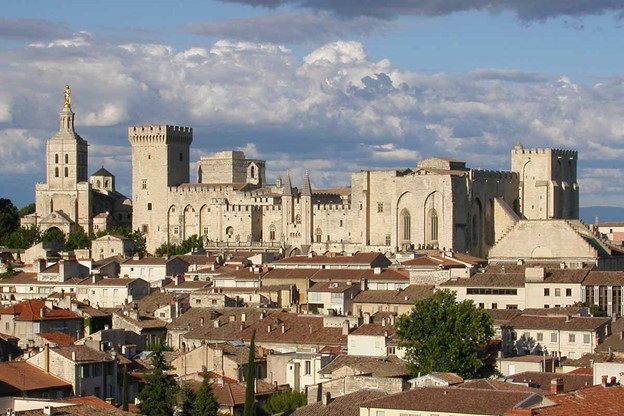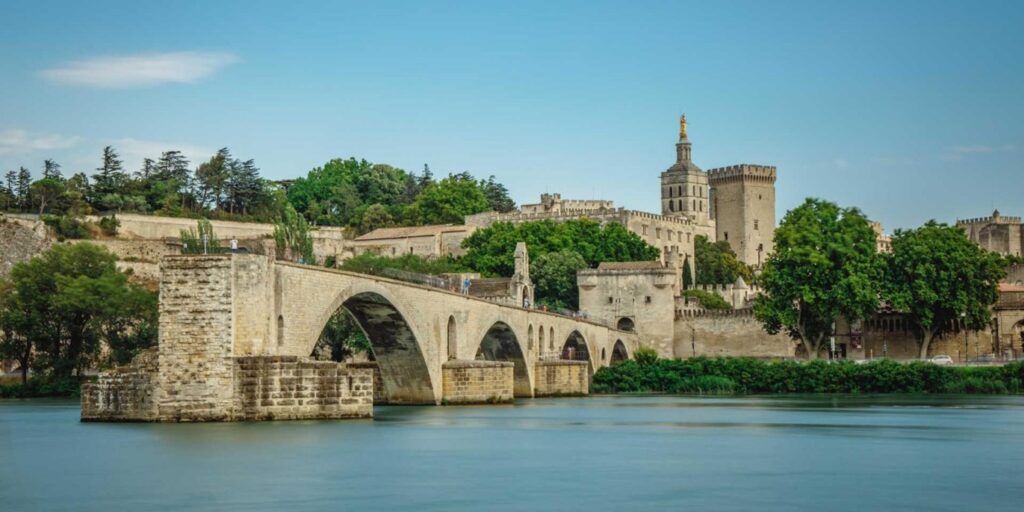Philadelphia is still bragging about the Declaration of Independence and the Liberty Bell. Boston hasn’t gotten over the Tea Party. Those things happened around 250 years ago. There is a place in France where they’re still identifying themselves with something that occurred more than 700 years ago: Avignon, in the south of France.
From 1309 through 1417, the Pope decided not to live in Rome but rather took up residence in Avignon. This all had to do with conflict between the Papacy and the Kings of France and is way too complicated to be explained here. The point for contemporary visitors is that everywhere you go in Avignon you’ll see the papal insignia of the Triple Crown and the crossed keys.
The Papal Palace in Avignon, with the cathedral to the left. Photo courtesy of Horizons Provence.
The most impressive and important site should you visit Avignon is the Papal Palace. It’s actually two joined buildings, erected by different Popes. It is one of the largest gothic edifices ever built. Its massive walls and battlements give witness to the perilous nature of the Avignon papacy, with the constant threat of attacks by the forces of various kings and church factions. As the center point of medieval western Christianity, the palace, and Avignon more generally, it became the administrative hub of Catholicism. It was the precursor to St. Peter’s Basilica in Rome, which was built 100 years after the return of the papacy there.
At the same time, Avignon is very much a living city. It is famous for its annual festival of the arts. There are performances in the courtyard of the Papal Palace and in theaters (and in the streets) around Avignon. Of course, most of the theatrical works are in French, with an occasional Shakespeare or other classic piece presented in English.
Saint Benezet’s Bridge, with the bell tower of the Avignon cathedral behind it. Photo courtesy of Provence-Alpes- Côtes d’Azur Tourism.
Of course, there’s a cathedral, Notre-Dame des Doms, next to the palace. Over the centuries, this church has collapsed, been reconstructed, abandoned in the Revolution and restored in the 19th century. Its bell tower hovers over the city and it is topped by a golden statue of the Virgin Mary that can be seen for miles around. There are also gardens worth visiting. The Doms is the rock on which Avignon was founded. Visitors can climb up to it from the cathedral, enjoy the greenery and the views over the Rhône and pretend to be Avignonais.
Avignon is the capital of the Vaucluse region, which contains most of the Côtes du Rhône vineyards. Nearby is a town wine lovers have heard of: Châteauneuf-du-Pape translated as “the Pope’s new castle”. (One of the Avignon Popes built it as a refuge in case of attack on the palace.) Avignon is a bustling little city , modern amongst all the antiquity. After seeing the Papal Palace and the cathedral, the best thing to do (other than wine tasting all around the city) is just to walk around, taking in many beautiful sectors and sights.
Finally, don’t miss Saint Benezet’s Bridge, or what’s left of it. If you remember the childhood song Sur le Pont d’Avignon (on the bridge of Avignon), this is it. Half of it collapsed centuries ago, but you can still dance there today, if you’d like to.

